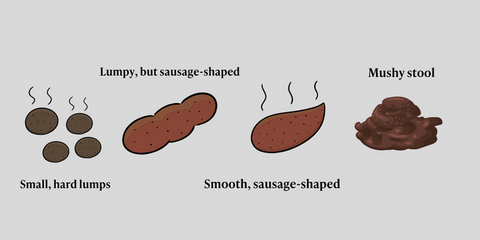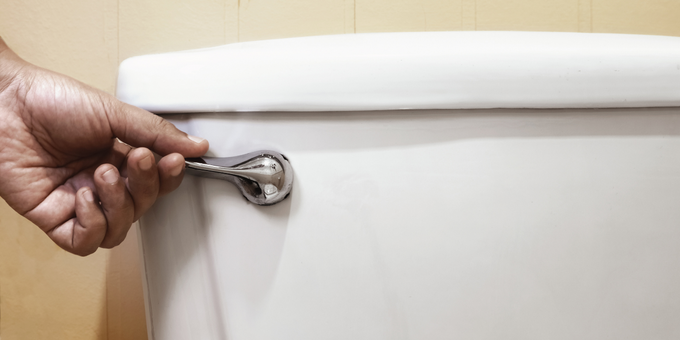It’s time to put your poo under the microscope – it can show you a great deal about your digestive health. Changes to your poo's appearance can indicate the presence of infection or even more serious bowel diseases, but it can also indicate that something is amiss with your diet.
Poor gut health is one of the major offenders when it comes to unhealthy stool – and the havoc it can wreak on your digestive system ranges from diarrhea and constipation to trapped wind and bloating. Take a look at what the shape, texture and colour of your poo is telling you.

Constipation.
If your stool looks something like the first type in the image above – lumpy and hard pieces which are difficult to pass – this indicates they’ve been sitting in the intestine for quite a while. You're probably experiencing constipation if this is looking familiar to you, and a lack of fibre could be responsible, as could irritable bowel syndrome or even a condition like Coeliac disease. Medication and stress may also factor in.
Diarrhea.
If your stool is liquid or mushy – like the fourth type in the image above – this indicates diarrhea. There can be a range of causes for this, from infection to food allergies and sensitivities, but often a poor diet can be to blame. If you’re eating a lot of sugary, fried or high trans-fat foods, this could be contributing to your runny bowel movements. Read on to find out how a few simple changes to your plate could help.
Healthy poo.
Your poo should generally be smooth and sausage-like, it’s also fine if it has some cracks in the surface. It should also keep its shape as it’s flushed down the toilet.
Stool colour.

Brown: This is the colour to aim for; it indicates a healthy digestive system.
Yellow: If your poo is yellow, this could suggest liver problems or the presence of metabolic diseases. It also indicates a higher fat content in your stool, which could be a result of not properly absorbing nutrients. Look out for a greasy texture and exceptionally bad smell – this could signal something is amiss with your digestive system – with pancreatitis or Coeliac disease on the list of numerous possibilities.
Grey: A lack of bile is often the cause of white or grey stool, and while this could indicate an obstruction in your gut – something worth heading to the doctor’s for – but it can also be a result of anti-diarrheal medication.
Bright red: This can indicate internal bleeding somewhere in your digestive tract, and hemerrhoids are one notable cause of this alarmingly-coloured stool. But, if you’ve recently gone to town on tomatoes, beetroot or cranberries, this could be the culprit.
Green: If you have green stool, a bacterial infection could be at play, but it could also be the result of antibiotics. It often indicates you’ve been experiencing diarrhea, and as such, the bile didn’t have the chance to break down. Again, the colour of the foods you eat can also play a role, with leafy greens or foods with green dye also possible causes.
Black: This is usually a bad sign, often indicating internal bleeding – but don’t panic, if you ate a lot of liquorice or took some iron supplements, this could also be to blame.
What you can do about it.
If your poo problems stem from an unbalanced, insufficient diet, there are few steps you can take to heal your gut health and prevent the development of serious digestive diseases. One step is to ensure you’re consuming enough fibre – this helps to reduce constipation. Opt for whole fruit, veggies, whole grains and nuts to get your fix of fibre.
Probiotics will also help tip the balance of good and bad bacteria in your favour. This is because our gut microbiome contains around 100 trillion bacteria, and getting a good dose of beneficial bacteria is your ticket to improved digestive health. Yoghurt, kefir, kimchi, kombucha and Sauerkraut are all good sources of probiotics.
But it’s not just about what you put on your plate – it’s what you keep off it. High-sugar diets are one of the biggest offenders when it comes to throwing our digestive health out of whack, resulting in uncomfortable symptoms like constipation and diarrhea, and also potentially leading to diabetes, obesity and live disease. Research shows sugar lowers microbial diversity and raises our risks for inflammation and a compromised gut microbiome. Proteobacteria, a type of bacteria found in our gut, has been found as drastically higher levels in those who ate excess sugar. Here’s the problem: too much of this indicates dysbiosis – a condition that is categorised by unbalanced gut bacteria, leading to all manner of health conditions.
If you suspect conditions like Coeliac disease, hemerrhoids or pancreatitis, while dietary changes may help the healing process, it’s essential to hit your doctor up for a check-up. They may recommend blood tests or a colonoscopy to get a clearer picture of your situation.
If you’re looking to ease the discomfort of poor digestive health and kick that sugar addiction for good, we’re inviting you to join us for our 8-Week Program. With exclusive meal plans and nutritious recipes that benefit your gut, there’s never been a better time to turn your life around. Here’s what’s on offer:
- 8 weeks of expert-crafted meal plans and shopping lists.
- 90+ member-only recipes.
- Community forums to share your journey.
- Support from the I Quit Sugar team, plus our panel of experts.
- Mental and physical health benefits that last a lifetime.
If you’re ready to transform your health, JOIN NOW!






Leave a comment (all fields required)